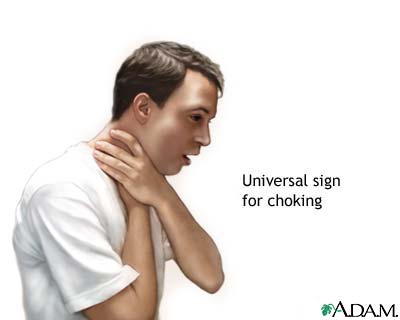Heimlich maneuver
Alternative names
Choking - Heimlich maneuver; Abdominal thrusts

Choking is fairly common. Choking deaths occur most commonly in children less than 3 years old and in senior citizens, but can occur at any age. The Heimlich maneuver has been valuable in saving lives and can be administered by anyone who has learned the technique.

Choking is the hindrance of breathing due to an obstruction of the throat or windpipe. The Heimlich maneuver should be conducted to try to dislodge the object.

Definition
The Heimlich maneuver is an emergency technique for preventing suffocation when a victim’s airway (windpipe) becomes blocked by a piece of food or other object. It can be used safely on both adults and children, but most experts do not recommend it for infants less than 1 year old. It can also be self-administered.
For a conscious victim who is sitting or standing, position yourself behind the victim and reach your arms around his or her waist. Place your fist, thumb side in, just above the victim’s navel and grab the fist tightly with your other hand. Pull your fist abruptly upwards and inwards to increase airway pressure behind the obstructing object and force it from the windpipe. The procedure may need to be repeated several times before the object is dislodged.
A related technique exists for a victim who is, or who becomes, unconscious.
If repeated attempts do not free the airway, an emergency incision in the windpipe (tracheostomy or cricothyrotomy) may be necessary. See further information on:
- Choking (for conscious infant under 1 year)
- Choking (for conscious adult or child over 1 year)
- Choking (for unconscious infant under 1 year)
- Choking (for unconscious adult or child over 1 year)
Diseases and Conditions Center
All ArmMed Media material is provided for information only and is neither advice nor a substitute for proper medical care. Consult a qualified healthcare professional who understands your particular history for individual concerns.